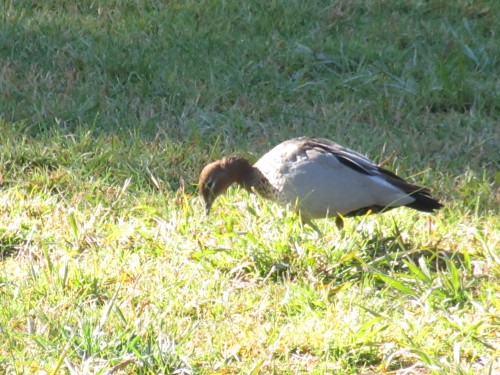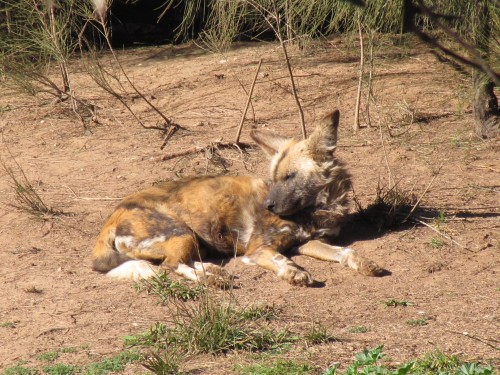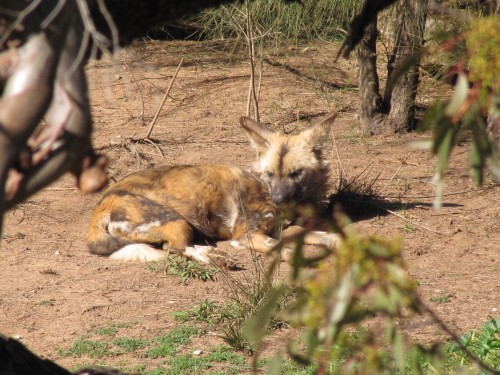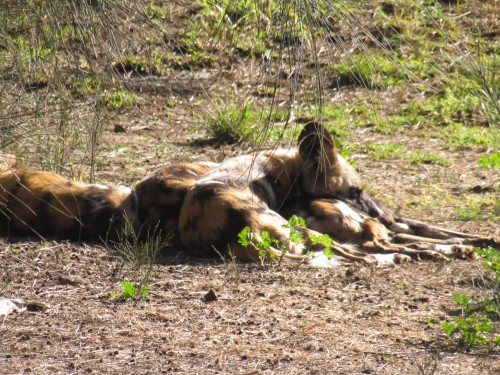Watch your back, duck
I was amazed at the danger this Australian Wood Duck had placed itself into. It was quietly grazing on the grass in the African Wild Dog enclosure at the Western Plains Zoo in Dubbo, and with its back to the pack sunning themselves about 30 metres away. They are cunning hunters and quite capable of sneaking up on an unsuspecting, tasty meal like a duck. I guess that they are well fed and have no need to chase after wildfowl, or any other birds which stray into their enclosure.
This reminded me of a guided tour we had a some years ago through our local Monarto Zoo, just 10km from my home here in Murray Bridge. The tour bus was slowly moving through the cheetah enclosure when the guide announced that the cheetahs loved running at full speed and catching the local ravens or magpies before they could get airborne again.
I decided then that I would never try to outrun a cheetah!
Magnificent Wedge-tailed Eagles
Last week I travelled from home in Murray Bridge to attend a meeting in Adelaide. I take the South-eastern Freeway and this takes me through the Adelaide Hills. I generally take quite an interest in the birds seen along the way, noting that more and more frequently I am seeing the wonderful Yellow-tailed Black Cockatoos flying overhead.
On this occasion, however, I saw two – perhaps a pair – of Wedge-tailed Eagles soaring low over the freeway. This magnificent species – Australia’s largest eagle – is widespread throughout the country without being very common anywhere.
As is quite usual both birds were being harassed by other species, including Australian Magpies and Little Ravens. While they might be lovely birds, they are generally not loved birds; at least, not in the bird kingdom.
Rock Martins and other birds, Ethiopia
Over recent days I have written about some of the birds I saw on a visit to the Portuguese Bridge area (near Debre Libanos) which is about 110km north of Addis Ababa in Ethiopia. There is some controversy over the old bridge (shown above). Local guides claim it was built by the Portuguese about 400 years ago. Other authorities claim that it was built more recently.
We were visiting the area last December. Geologically it is a very interesting place. We had wonderful views over the valley and down into the Blue Nile Gorge about 1000 metres below us. I’ve included no bird photos today – only scenery shots of this amazing place.
I saw a good number of birds and if you look through recent posts here you will see photos of some of them. Instead of bird photos I have compiled an annotated list of some of the birds seen:
- Pied Crow – numerous
- Fan-tailed Raven – 3 flying overhead
- Lammergeier – 1 soaring on thermals overhead
- Yellow-billed Kites – numerous – about 20 – 30 swooping low over people eating lunch. One took food from my fingers!
- Dusky Turtledove – about 5 seen
- Speckled Pigeon – only 1 seen
- Tacazza Sunbird – 2
- Rock Martin – about 10 swooping around the cliff edges
- Blue-breasted Bee-eater – 2 seen swooping for insects and then sitting on a branch
- Augur Buzzard – one seen only briefly, flying overhead
I saw and heard a number of other species but either didn’t get good views of them or no views at all. One of the more frustrating sightings was that of the Rock Martins swooping around the cliff edges. They came quite close – close enough for good identification – but none settled down to perch so I could get a photo. On the wing they were too swift to focus on. [Sigh]
So – you’ll have to be content with some lovely scenery shots instead. But stay tuned for more photos taken elsewhere in the coming days.
Fantailed Raven, Ethiopia
On my visit to Ethiopia late last year I saw many crows and ravens, especially the very common Pied Crow. The species I feature today, the Fan-tailed Raven, I saw only on one occasion. We had driven north about 100km from Addis Ababa to Portuguese Bridge. I managed to get a few good photos and added several species to my list.
The Fan-tailed Raven certainly has a very descriptive name, and to see them soaring on thermals overhead the fanned out tail helps considerably in the identification process. You can see this in the photo below.
This species is widespread throughout north eastern Africa and in parts of the Sahara. It feeds on insects and other invertebrates, food scraps, fruit, carrion and even grain.
Further reading:
Thick-billed Ravens, Addis Ababa
One of the bird species I recorded on only a few occasions during my two week stay in Ethiopia last December was the Thick-billed Raven. Only once did I manage to get a few photos of this species, shown here today on this post. They were very easily distinguished from the locally common Pied Crows by being almost completely black except for a white patch on the nape. They are considerably bigger than the Pied Crow too. Their thick bill is hard to miss and is diagnostic.
Along with the Common Raven, they are the largest in the corvid family of birds (click here for a definition). They are found only in the Horn of Africa (Ethiopia, Eritrea and Somalia). Their diet is quite varied, and being omnivorous they will eat insects, beetles, carrion, meat scraps and a range of human foods.












